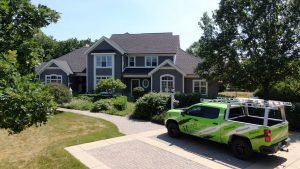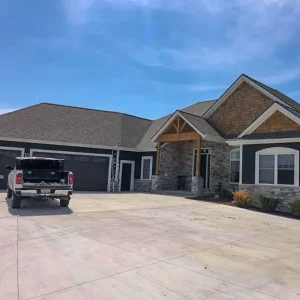When your home’s windows start fogging up, letting in drafts, or sticking shut every time you try to open them, it’s more than an annoyance, it’s a sign something needs attention. Homeowners often come to us unsure what the full process actually involves, from that first call to the day we finish the install.
You’re not just replacing glass, you’re improving comfort, lowering energy bills, and protecting your home from Wisconsin’s unpredictable weather. This guide breaks down each step of the window replacement process, with a focus on transparency around timing, costs, and how to avoid common missteps.
At Heins Contracting, we’ve replaced thousands of windows across Southern Wisconsin. Our team combines local know-how with a no-nonsense approach, so you’re always clear on what to expect.
It’s not just “swap and done”
We’ve met many homeowners who assume window replacement is a quick swap, measure, install, done. But that skips over critical details that affect how well your windows perform over the next 20 years.
We’ve seen brand-new windows fail after just 5 years due to poor install alignment or skipping insulation seals. The biggest issue? Rushed planning or inaccurate measurements.
Reality check: The prep and planning stages take more time than most homeowners realize, and they matter more than the install itself. Skipping the details upfront often means trouble later.
Warning: If someone gives you a same-day quote without inspecting your existing frames, they’re guessing. That guesswork can cost you hundreds in unexpected trim work or reframing.
Step 1: Getting it right from the start — the consultation
What happens during the first visit
We come out to your home and inspect every opening, including frame condition, wall depth, sill slope, and airflow issues. If you’ve had ice buildup or noticeable drafts, we’ll identify where energy is escaping.
We also measure down to ⅛” to ensure custom window orders fit perfectly. Vinyl and fiberglass windows expand and contract at different rates in Wisconsin’s seasons, getting sizing right matters.
Note: Older homes with wood frames or shifting foundations often need additional carpentry prep before installation. We flag that early so it doesn’t surprise you later.
Step 2: Choosing materials that fit your home
Frame options and performance factors
Window frame material affects durability, insulation value, and price. We’ll walk you through options like:
- Vinyl – Most affordable and low-maintenance. R-value typically around 0.9–1.1.
- Fiberglass – Higher strength and insulation, with R-values up to 1.4.
- Wood or composite – Great for historic homes but require maintenance.
We also review glass types. Double-pane with Low‑E coatings is standard, but in areas exposed to full sun or cold wind, triple-pane upgrades (R-value 3.1+) often pay off within 3–5 winters.
Pro tip: Ask about U-factor and SHGC, not just brand names. A U-factor under 0.30 is ideal for our climate zone.
Step 3: Ordering and prep work
Timeline and what to expect
Once you approve your window selection, we order custom-built units. Lead time averages:
- 3–4 weeks for standard vinyl
- 4–6 weeks for fiberglass or triple-pane
- 6–8 weeks for wood or specialty shapes
While we wait, we’ll schedule removal of storm windows, coordinate permit paperwork if needed, and prep trim or flashing adjustments.
Reality check: Schedules can shift due to supply backlogs, especially for specialty finishes. A reputable contractor will keep you in the loop, radio silence usually means disorganization.
Step 4: Installation day — what really happens
The process from teardown to seal-up
A full-frame window replacement (vs. insert-only) takes longer but ensures better insulation and framing repair. Expect:
- 30–60 minutes per window for removal and replacement
- Rigid insulation or spray foam sealing around the frame
- Exterior trim or flashing tape install for water tightness
- Cleanup, caulking, and final inspection
On a typical home with 10–15 windows, installation takes 1–2 days depending on weather and access.
Warning: Cutting corners on sealing, especially during winter installs, can lead to condensation and early failure. Make sure installers insulate, not just “fit” the window.
Pro tip: If your contractor doesn’t use flashing tape or foam insulation at install, ask why. It’s not optional in our climate, it’s a must.
Step 5: Final walkthrough and warranty coverage
What you should look for before signing off
We’ll walk through each window with you to confirm:
- Locks, sashes, and screens operate smoothly
- Caulking is even and sealed on all edges
- No gaps in interior trim or cold drafts
You’ll receive a written workmanship warranty, usually 10 years, and material warranties depending on brand (some offer 25 years or lifetime on glass seals).
Note: Warranties only hold if windows are installed per spec. DIY or “handyman” installs may void coverage entirely.
Seasonal considerations: When to replace in Wisconsin
Winter installs vs. summer timing
Cold weather doesn’t prevent replacement, but it does affect cure times for caulk and foam. We use low-temp rated sealants when needed.
Spring and fall offer the best install conditions. But we also offer window-at-a-time replacement during winter if full install isn’t possible due to below-freezing temps.
Reality check: You don’t need to delay just because it’s January. What matters is who’s doing the install and how they manage the weather exposure.
FAQ
How long does a full window replacement take?
Most homes are completed in 1–2 days, but ordering windows takes 3–6 weeks depending on material. The full timeline from quote to completion is about 6–8 weeks.
What’s the average cost of replacing windows in Wisconsin?
You’ll typically pay $650–$1,100 per window installed, depending on frame type, glass features, and trim needs. Wood and triple-pane options fall at the higher end.
Can I replace just one or two windows?
Yes, though replacing in batches (3–5 windows) often brings better pricing. One-off replacements still follow the full consultation and install process.
Will replacing windows improve energy efficiency?
Absolutely, especially if your current windows are single-pane or lack Low‑E coatings. New windows can cut energy loss by 20–30%, especially in older homes.
Ready to move forward without the guesswork?
It’s not just about the glass, it’s about getting it right from start to finish. Rushing the process or choosing low-cost installs often backfires when gaps appear or windows stick after a season.
If you’re weighing DIY vs. pro install, consider the real risks: voided warranties, missed insulation gaps, and a lot more caulking than expected. For Wisconsin homes, proper flashing and insulation matter as much as the window itself.
We handle the entire process, consultation, measurement, material guidance, and certified install, with a focus on precision and long-term performance. If you want a clear path from drafty to done, we’re ready when you are.




